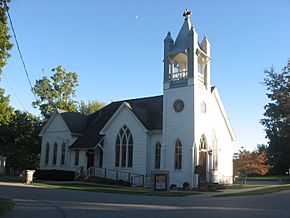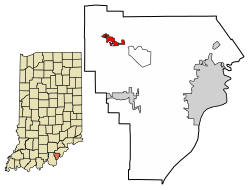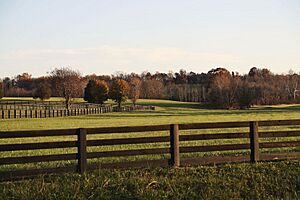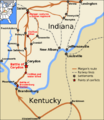Greenville, Indiana facts for kids
Quick facts for kids
Greenville, Indiana
|
|
|---|---|
| Town of Greenville | |
 |
|

Location of Greenville in Floyd County, Indiana.
|
|
| Country | United States |
| State | Indiana |
| County | Floyd |
| Township | Greenville |
| Area | |
| • Total | 0.90 sq mi (2.34 km2) |
| • Land | 0.90 sq mi (2.34 km2) |
| • Water | 0.00 sq mi (0.00 km2) |
| Elevation | 827 ft (252 m) |
| Population
(2020)
|
|
| • Total | 1,365 |
| • Density | 1,509.96/sq mi (582.88/km2) |
| Time zone | UTC-5 (EST) |
| • Summer (DST) | UTC-4 (EDT) |
| ZIP code |
47124
|
| Area code(s) | 812 & 930 |
| FIPS code | 18-29844 |
| GNIS feature ID | 0435458 |
| U.S. Highway | |
| Major State Roads | |
| Website | http://www.visitgreenvillein.com |
Greenville is a small town located in Floyd County, Indiana, in the United States. It's part of the larger Louisville metropolitan area. In 2020, about 1,365 people lived here.
Contents
A Look Back in Time: Greenville's History
How Greenville Began
Greenville was planned out in 1816 by Andrew Mundell and Benjamin Haines. This was three years before Floyd County was even officially created! For its first few years, Greenville was actually part of Clark County.
Famous People from Greenville
The Story of John Baptiste Ford
Captain John Baptiste Ford arrived in Greenville as a 14-year-old runaway. He started working as an apprentice in a saddle shop. This led him to buy the "Old Mill" and saddle shop. He added a grocery and began making tin pie safes to sell.
Later, Ford moved to New Albany and started many businesses. He was the first person to successfully make plate glass in the United States. This success led to the creation of several glass companies, including the famous Pittsburgh Plate Glass Company (now called PPG). Because of his work, Ford is known as the "father of American plate glass."
The original building where Ford's mill, saddle shop, and grocery were located is still standing today. It's known as the "Old Mill" or "Ford's Flour Mill" and is thought to be the oldest business building in Greenville. It was built between 1810 and 1812. In 1840, Ford helped build the brick structure you see today.
Besides Ford's businesses, the "Old Mill" was also the Greenville Post Office from 1823 until the early 1940s. It was a stop for a 104-mile stagecoach route and even a stop on the Pony Express route from 1861 to 1867. For much of the early 1900s, people called it the "lodge building" because it hosted meetings for groups like the Masons.
Ford was very generous. He helped pay for the Simpson Memorial United Methodist Church in 1899. In 2017, a road was named "John Baptiste Ford Drive" to honor him. In 2019, a special historic marker was placed in Greenville to remember his important contributions.
Other Notable Residents
- Norman Jay Colman: He was the first principal in Greenville in 1850. Later, he became the first Secretary of Agriculture for the United States in 1889.
- Roscoe Miller: He was a professional baseball pitcher who played for teams like the Detroit Tigers and Pittsburgh Pirates.
Greenville During the Civil War
During the American Civil War, Confederate General John Hunt Morgan and his troops came through Greenville on July 10, 1863. This event is known as Morgan's Raid. After a battle in Corydon, some of Morgan's soldiers passed through Greenville. They even burned a railroad bridge nearby.
A Greenville resident named Ephraim L. Girdner joined the Union Army in 1861. He was captured by Confederate soldiers in 1862. He later became a Captain and was part of Sherman's March to the Sea. His family saved many of his letters and military papers from the war.
Becoming the County Seat?
Early in Floyd County's history, Greenville was considered to be the county seat (the main town for government). It was a competition between Greenville and New Albany. The town that offered the biggest donation would win. New Albany won by offering a bell for the courthouse, which was an offer Greenville couldn't beat.
Greenville Becomes a Town
Greenville was officially surveyed and became an incorporated town on October 28, 1879.
The Great Fire of 1908
On March 26, 1908, a big fire destroyed many of Greenville's original buildings. The "Station" (the Old Mill building) survived, and it's just two doors down from one of the town's oldest homes, which was rebuilt in 1908. This home still has some of John B. Ford's original plate glass!
The Town Flag
The Greenville Town Flag was designed by Glenn Burkhart in 1969. He was only a 5th grader at Greenville Elementary School at the time! His design won a contest held by the town. Glenn received a $25 bond as his prize. His original drawing and the first flag from 1969 have been saved. In 2019, there was a special ceremony to celebrate the flag's 50th anniversary.
Historic Buildings to See
Greenville has several buildings with interesting histories:
- Simpson Memorial United Methodist Church: This beautiful church was designed by Benjamin D. Price and built in 1899. It was added to the National Register of Historic Places in 2004.
- Jersey Park Farm: This historic home and farm is just outside Greenville. The farmhouse was built around 1875. It was also added to the National Register of Historic Places in 1984.
- The Station: Built in 1840 by John Baptiste Ford, this is the oldest commercial building in town.
Where is Greenville?
Greenville covers about 0.90 square miles (2.34 square kilometers) of land. It's surrounded by other townships. For example, to the northwest is Jackson Township in Washington County. To the east is Laffayette Township in Floyd County.
Two creeks, Big Indian Creek and Little Indian Creek, flow through the area. These creeks eventually lead to the Ohio River.
How Many People Live Here?
| Historical population | |||
|---|---|---|---|
| Census | Pop. | %± | |
| 1880 | 394 | — | |
| 1890 | 313 | −20.6% | |
| 1900 | 309 | −1.3% | |
| 1910 | 227 | −26.5% | |
| 1920 | 225 | −0.9% | |
| 1930 | 257 | 14.2% | |
| 1940 | 285 | 10.9% | |
| 1950 | 298 | 4.6% | |
| 1960 | 453 | 52.0% | |
| 1970 | 611 | 34.9% | |
| 1980 | 537 | −12.1% | |
| 1990 | 508 | −5.4% | |
| 2000 | 591 | 16.3% | |
| 2010 | 595 | 0.7% | |
| 2020 | 1,365 | 129.4% | |
| U.S. Decennial Census | |||
In 2010, there were 595 people living in Greenville. By 2020, the population had grown to 1,365 people.
Most of the people living in Greenville are White (95.5% in 2010). About 40.6% of households had children under 18 living with them. The average age in town was about 40.3 years old.
Schools in Greenville
Students in Greenville attend schools that are part of the New Albany-Floyd County Consolidated School Corporation.
- Greenville Elementary School is right in town.
- Older students go to Highland Hills Middle School.
- For high school, students attend Floyd Central High School.
Images for kids
See also
 In Spanish: Greenville (Indiana) para niños
In Spanish: Greenville (Indiana) para niños









